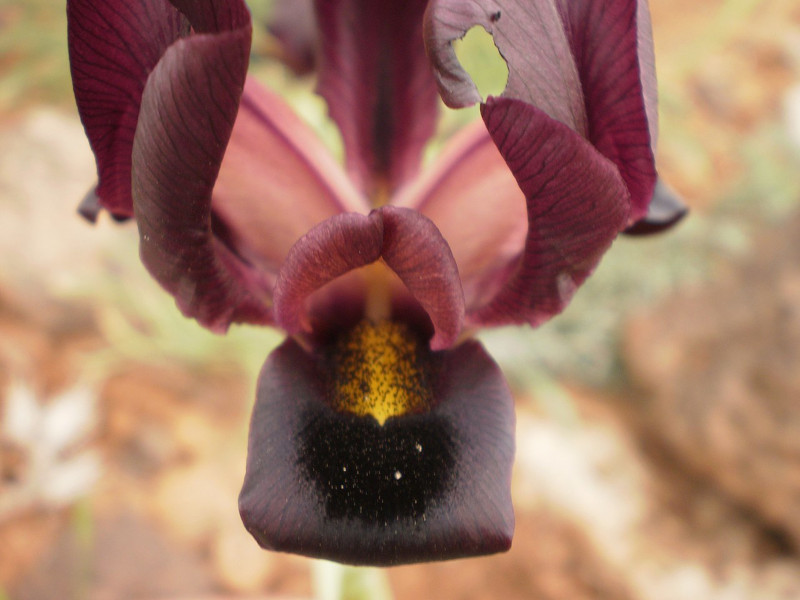Petra Iris Facts
- This gorgeous product of Nature and evolution most frequently goes by the somewhat informative common name of the Petra Iris. For the moment, the stunning Angiosperm has no other generally accepted non-scientific moniker by which it’s known.
- Scientific professionals, meanwhile, such as researchers, use its formal name when referring to it. Thankfully for those among us who aren’t scientists, that’s a relatively easy name, as such go. That’s because it bears the formal name of the Iris petrana.
- It received that title due to the work of the respected American botanist, John Edward Dinsmore. He accomplished the first official acknowledgement of the plant as a separate and distinct species. It also bears its name in honor of the ancient city of Petra.
- For the moment, the IUCN has no listing of the species on its Red List of Threatened Species. The exact reasons for this omission remain unclear, however. At least one country within its range, however, formally lists it as an Endangered Species.
- Since the 1950’s, a dramatic decline in its population has been noted by officials. Conservation efforts are underway, in some regions, though. In one country, its only known, very tiny population grouping now lies within the confines of a Nature Reserve.
- Regrettably, the marvelous Petra Iris faces several threats to its existence. In the near term, uncontrolled grazing by local animals poses a danger. It’s also often picked by locals. The greatest threat it faces in the long term, though, is climate change.
Related Articles
Petra Iris Physical Description
The stunning Petra Iris serves as yet another example of the fact that Nature places no importance on sheer physical size. That’s true since this plant develops as a relatively small one. That holds particularly true in comparison with many of its closely related species.
This botanical wonder of evolution develops from rootstalks, known as rhizomes. Each stalk produced by this structure further develops as comparatively thin and erect. These stay short, however. An average height, in fact only equals approximately 10 in (25 cm).
These stalks also produce multiple leaves, developing near the base. This folaige has an elongated, sword-like shape. Each also manifests a light grayish-green color. Evolution also provided the several leaves each flower develops with a thin, waxy coating for its protection.
It’s the remarkable blooms of the Angiosperm, though, that garner the most interest. That’s due to their highly distinctive pattern of coloring. Intriguingly, these appear in several, various dark shades. Those range from brown or a burgundy hue, to dark violet or purple.
Some specimens of the amazing Petra Iris, however, in the right lighting, appear to possess a wholly black shade! It’s these specimens that understandably attract the most interest. Its two sets of petals also have different appearances. One evolved a set of beard-like hairs.
- Kingdom: Plantae
- Phylum: Angiosperm
- Class: Monocots
- Order: Asparagales
- Family: Iridaceae
- Genus: Iris
- Species: I. petrana
Petra Iris Distribution, Habitat, and Ecology
Unfortunately, the tantalizing Petra Iris evolved as native to an extraordinarily restricted zone of habitation. That description as unfortunate applies to both the plant itself, and those of us who appreciate Nature. It’s also currently unknown if it ever appeared elsewhere.
In general, its evolution placed it within the confines of the temperate zones of the continent of Asia. There, however, it appears in only a few, very tiny areas. These include near one town in southern Jordan, the Negev Desert, in Israel, and the Dead Sea Basin.
To the astonishment of many individuals, the intrepid plant also developed as native to habitat types hostile to most of its related species. Incredibly, this Angiosperm makes its home in highly arid regions. More specifically, it’s actually an established desert-dweller!
It also appears in related regions, though. These consists of areas of marginal lands next to the same desert sections. All known concentrations of this marvel of Nature share yet another limitation. These all appear at elevations ranging from 1,410 – 1,870 ft (430 – 570 m).
In the wild, the Petra Iris most commonly propogates via seeds. This action may also be accomplished via the rhizomes it produces, however. Those same seeds, though, spread by a combination of methods. The wind blows some, yes, but local insects also carry others away.
Like many of its relatives, this delicate flora also evolved as moderately toxic in nature. This further applies to most parts of the species. If ingested, stomach discomfort and vomiting often occur. Even handling certain parts of the plant sometimes causes irritation of the skin.
Species Sharing Its Range
Check out our other articles on 5 Surprising Freshwater Animals, Wilson’s Bird-of-paradise, Blood Falls, Porbeagle, Indo-Pacific humpback dolphin, Asian Weaver Ant, Anegada ground iguana

